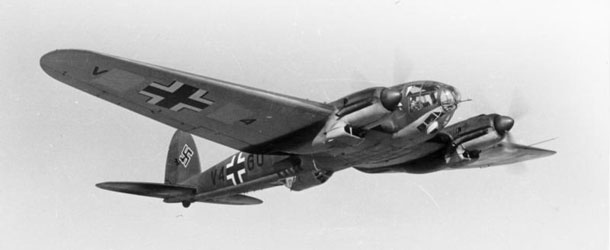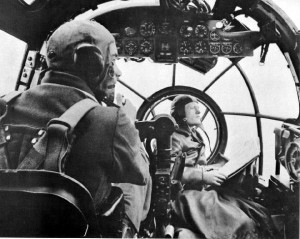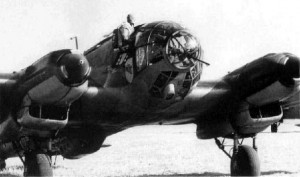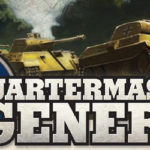The bombers will soon arrive for the WW2 Wings of Glory game, with two aircrafts to be released soon: the German Heinkel He.111 and the North American B-25 Mitchell, each one presented in two different versions. In this first preview article, we present the Heinkel He.111, which was the Luftwaffe’s bombing mainstay in the early years of the WW2.
Designed by Siegfried and Walter Günter in the early 1930s, the Heinkel He.111 is often described as a "Wolf in sheep's clothing”. By that time, the Treaty of Versailles had forbidden Germany to have an air force, and this aircraft was developed as for civilian transport, but in such a way that it could be easily converted into a bomber, providing the upcoming Luftwaffe with a fast medium bomber.
Easily recognized for the distinctive, extensively glazed, bullet-shaped "greenhouse" nose of some versions, the Heinkel He.111 was able to inflict a substantial bomb load onto various targets and defend itself from aircraft attack with its formidable array of self-defense machine guns.
The He.111 was developed into a myriad of variants that would include dozens of sub-variants, and had a long and successful career, through the Spanish Civil War, the Battle of Britain, Stalingrad, and even after World War Two, in service with the air forces of Spain, Turkey, and other countries.
The broad dihedral wings gave excellent stability and the ability for the He.111 to carry heavy loads. The fuselage and tail section were made of metal, including the skin, which allowed great durability, and sometimes the He.111 could even fly with a destroyed elevator. The crew varied according the variant, from 4 to 6. The pilot sat on the left and the bombardier on the right into the cabin, and the gunners and radio operator were sit in a gangway between the bomb racks, back to the rear compartment.
The armament also changed in different versions of the He.111, but in average these bombers were armed with a 20-mm MG FF cannon, a 13-mm (0.51-inch) MG 131 machine gun, three 7.92-mm (0.31-inch) MG 81Z machine guns and bomb-load from 1,000 to 2,000 kg.
Development and usage
The first prototype of the Heinkel He.111 (He.111a, later re-designated He.111 V1) flew in February 1935 and it was an enlarged, twin-engine version of the single-engine mail-liaison He 70, which set eight world speed records in 1933. Powered with 660hp BMW V.1.6.0 Z engines, the He.111 V1 was able to reach 349 Km/h. The second and the third prototypes, the He.111 V2 and He.111 V.3, had shorter wingspan.
The V3 was the first prototype of a He.111 commercial version, soon followed by the He.111 V4. Capable of carrying 10 passengers and mail, it was publicly disclosed as a fast civilian airliner, in January 1936, and after flying tests 10 aircrafts were delivered to Lufthansa, equipped with 880hp Daimler Benz DB 600C engines.
The V2 was the first true bomber prototype and led to the pre-production of the medium-bomber He.111A-0 in early 1936. Ten aircrafts built had an extended nose with extensive glazing for the navigator / bombardier, and a maximum bomb load of 1,000 kg, with no changes in the power plant. The first military trials revealed that these aircrafts were underpowered and so they were rejected for the service and sold to China.
The same airframe was the base for the He.111e, later called V5. It was armed with 7.92mm MG 15 machine guns in the nose, dorsal and ventral positions, and had an interior bomb bay for a 1000 kg. With the wingspan reduced to 22.61m and retrofitted with two 950hp Daimler-Benz DB600A, this version achieved the designed performance, reaching a maximum speed of 360 km/h, and impressed Luftwaffe, entering in production in 1936 as the He.111B.
They equipped the six Kampfgschwader (KG bomber wing) and 30 aircrafts were sent to Spain, assigned to the K88 unit of German Condor Legion, in support of Franco's Nationalists in the Civil War.
Other variants followed, in the effort to redesign its structure to reduce the manufacturing time. The Henkel He.111 E and He.111 F were the first mass-production versions. The aircraft was continuously upgraded, and several different versions were used in multiple roles.
The H variant, fully glazed nose with no wind screen steps and offset ball turret, powered with 820 kW (1,100 hp) Junkers Jumo 211 engines, was the more widely produced and saw more action during World War II than any other. While this aircraft was primarily a medium bomber, the H variant was also adapted as a torpedo bomber, a glider-bomb carrier, and even as a balloon-cable cutter. There were over 400 He.111Hs in service by September 1939 and more than 5,000 were built by late 1944.
The Heinkel He.111 served on all the German military fronts in the European Theatre of World War II. Beginning the war as a medium bomber, it supported the German campaigns in the field until 1943. They were employed to attack Polish airfields, supply lines and cities, leading to the Poland surrender in October 1939, and then in the assault to Norway and Denmark in April 1940, and France and Low Countries the following month.
By mid 1940, when Germany started the attack to British targets, the He.111’s proved to be vulnerable to the Hurricanes and Spitfires of the Royal Air Force (RAF). They were armed with more defensive firepower: additional machine guns in the nose and tail, and a 20mm cannon in the ventral gondola, necessarily with more crew to serve the guns, slowing the aircrafts considerably. In September 1940, the Luftwaffe switched from daylight to night bomber raids, reducing the He.111 vulnerability, but affecting the bombing accuracy. Following, due to the Western Allied and Soviet air superiority, the He.111 was mostly reverted to a transport aircraft role, being operated until the end of the war.
More than 7,300 Heinkel He.111 had been built for the Luftwaffe by autumn 1944, with another 236 being built by the Spanish manufacturer, CASA, during and after the war (as the CASA 2.111). In service with the Luftwaffe from 1937 to 1945, the Heinkel He.111 remained in Spanish service until 1965.
In the next preview article, you will know how the Heinkel He.111 is featured in the WW2 Wings of Glory game.
Information sources: Ace Pilots, Military Factory, Warbird Alley, WWII Vehicles, Wikipedia.
Credit of picture on the top: Bundesarchiv, Wanderer,W., 1940.












